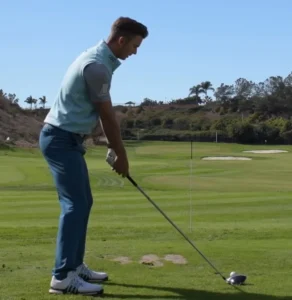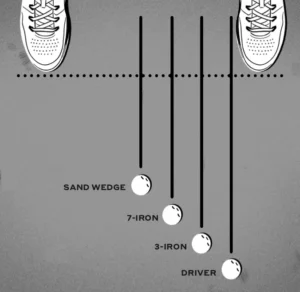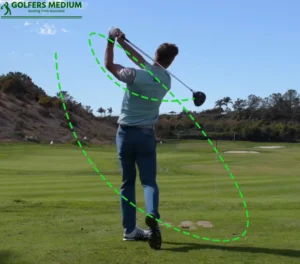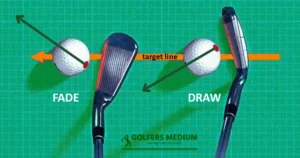If you’re an avid golfer, chances are you possess a signature shot that sets you apart. It could be a skillful high cut that adapts effortlessly to any club in your arsenal. Or perhaps you rely on a reliable low draw that seldom lets you down.
But here’s a question: are you familiar with hitting the opposite shot? When circumstances take a turn for the worse and your ball finds itself in a treacherous spot, do you possess a strategic approach to extricate yourself from trouble?
Enter the legend himself, Tiger Woods, widely hailed as the “Goat” of golf. Despite the modern constraints imposed by clubs and golf balls, Tiger has time and again defied all odds with his remarkable shot-making abilities.
Take, for instance, his unforgettable fairway bunker shot at the WGC Mexico tournament. Against all logic, Tiger expertly maneuvered a 9-iron around a daunting tree, executing a jaw-dropping 20-yard slice and an unconventional follow-through. The ball, imbued with a prodigious left-to-right spin, gracefully found the green, settling a mere 11 feet away from the hole. Although he narrowly missed the ensuing putt, a moment of surprise, it remains one of the most awe-inspiring shots witnessed in recent memory. It’s safe to say that very few individuals on this planet possess the prowess required to replicate such a feat.
Let’s face it, every golfer encounters a handful of challenging situations during a round. However, it is how we rebound and tackle these shots that can have a profound impact on our overall performance. Often, a demanding shot can serve as a turning point, rescuing a round from the brink and providing an immense boost of momentum.
Allow me to share with you some valuable insights on channeling your inner Tiger, enabling you to execute extraordinary shots in the future.
Here’s a step-by-step guide on how to shape your golf shots:
Understand the Basics
Familiarize yourself with the two primary shot shapes in golf—fade and draw. A fade moves from left to right (for a right-handed golfer), while a draw moves from right to left. Knowing the desired shot shape will help you visualize the intended trajectory.
Adjust Your Grip
Make slight adjustments to your grip to shape your shots. For a fade, try rotating your hands slightly to the left (clockwise for right-handed golfers), which promotes an open clubface. On the other hand, for a draw, rotate your hands slightly to the right (counter-clockwise for right-handed golfers) to encourage a closed clubface.
Align Your Body

Proper alignment is crucial for executing the desired shot shape. If you want to hit a fade, aim your body slightly to the left of your target (for right-handed golfers), aligning your feet, hips, and shoulders leftward. For a draw, align your body slightly to the right of your target, with your feet, hips, and shoulders aligned rightward.
Adjust Ball Position

Depending on the shot shape, you may need to modify the ball’s position in your stance. To hit a fade, position the ball slightly forward in your stance, closer to your left foot (for right-handed golfers). For a draw, move the ball slightly back in your stance, closer to your right foot.
Swing Path

The swing path plays a crucial role in shaping your shots. For a fade, try to swing along an out-to-in path, which means the clubhead will travel slightly from outside the target line to inside through impact. Conversely, for a draw, focus on an in-to-out swing path, where the clubhead moves from inside the target line to outside through impact.
Clubface Alignment

Aligning your clubface correctly is essential for shaping shots. For a fade, aim the clubface slightly open to the target, pointing to the right (for right-handed golfers). To hit a draw, close the clubface slightly, pointing left of the target.
Adapt to Different Clubs
Keep in mind that the process of shaping shots may vary with different clubs due to their design and loft. Experiment with different clubs and make necessary adjustments to achieve the desired shot shape.
Types of Golf Shots
Full Swing
This is the standard, full-power shot used for longer distances, typically with the driver or irons. The objective is to strike the ball with maximum power and distance while maintaining accuracy.
Pitch Shot
A pitch shot is played with a higher-lofted club, such as a wedge, to hit the ball a shorter distance with greater accuracy and control. It is often used when the player is closer to the green and needs to clear an obstacle or stop the ball quickly.
Chip Shot
A chip shot involves using a lower-lofted club, like a 7-iron or a pitching wedge, to hit the ball a short distance with minimal airtime and more roll. It is employed when the player is near the green and wants to get the ball closer to the hole.
Bunker Shot
When the ball is in a sand bunker, a specialized bunker shot is necessary. It involves using an open-faced club (typically a sand wedge) to strike the sand behind the ball, propelling it out of the bunker and onto the green.
Flop Shot
The flop shot is a high, soft shot played with a highly lofted club (such as a lob wedge) to clear an obstacle, such as a bunker or a steep lip around the green. It requires a delicate touch and precise execution to achieve a short carry and quick stop on the green.
Draw Shot
A draw shot is a shot that curves gently from right to left (for right-handed golfers) or left to right (for left-handed golfers). It is achieved by generating a clockwise spin on the ball, promoting a controlled curve in the desired direction.
Fade Shot
In contrast to the draw shot, a fade shot curves gently from left to right (for right-handed golfers) or right to left (for left-handed golfers). It involves imparting an anticlockwise spin on the ball, resulting in a controlled curve in the intended direction.
Frequently Asked Questions
What is shot shaping in golf?
Shot shaping in golf is when you purposely make the golf ball fly in a certain way by adjusting your swing and club position.
It’s like being a skilled magician on the golf course. You can make the ball curve left or right, go higher or lower, all by making small changes in how you hit the ball. It’s a way to show off your skills and have fun while playing.
How do you practice shaping shots?
- Understand the types of shots: Familiarize yourself with different shot shapes such as fades, draws, high shots, low shots, and so on. Learn about the effect each shot has on the ball’s trajectory.
- Identify your target: Select a specific target or landing area for your shots. It could be a flag on the golf course or a specific spot on the driving range.
- Visualize the shot: Before addressing the ball, visualize the shot shape you want to achieve. Imagine the ball curving in the desired direction and landing precisely on your target.
- Adjust your setup: Make necessary adjustments to your stance, grip, and alignment based on the shot shape you want to execute. For example, for a fade, align yourself slightly left of the target and strengthen your grip.
- Focus on the swing path: The swing path plays a crucial role in shaping shots. For a fade, swing from the inside-out, while for a draw, swing from the outside-in. Practice controlling the path of your swing to influence the shot shape.
- Experiment with clubface angle: Alter the clubface angle at impact to manipulate the shot shape. To fade the ball, open the clubface slightly, and to draw it, close the clubface slightly. Experiment with different degrees of adjustment to find the desired shape.
- Start with smaller shots: Begin by practicing shaping shots with shorter clubs like wedges or short irons. As you gain proficiency, gradually progress to longer clubs.
- Practice on the range: Spend time on the driving range practicing your shot shaping skills. Focus on hitting different shot shapes consistently and observing the ball flight. Analyze the results and make adjustments as necessary.
What is chunking a golf shot?
When you “chunk” a shot in golf, it means you’ve made poor contact by striking the ground before hitting the ball. This results in a shot that falls short of your intended distance and may leave a divot on the turf.
Chunking happens when you hit the ground behind the ball, causing your clubhead to lose momentum and resulting in an ineffective strike. It can occur due to various factors, such as improper weight transfer, incorrect technique, or a lack of focus during your swing.
Chunking a shot can be frustrating as it leads to a loss of distance and control. Your ball may travel only a short distance, requiring you to hit a longer shot to reach your target. Moreover, the trajectory of the chunked shot may not be what you intended, making it difficult to navigate hazards or achieve your desired outcome.
To avoid chunking shots, focus on the following:
Maintain Proper Weight Transfer: Ensure you have a balanced and stable stance throughout your swing. Shift your weight from your back foot to your front foot during the downswing to maintain control and prevent hitting the ground too early.
Position the Ball Correctly: Place the ball in the right position relative to your stance. Placing it too far back can lead to hitting the ground first and chunking the shot. Experiment with ball position to find what works best for you.
Strive for Solid Impact: Concentrate on making crisp and clean contact with the ball. Aim for a descending strike, with the clubhead reaching its lowest point after the ball. This promotes clean contact without hitting the ground prematurely.
Do more pros hit a fade or draw?
Fade is commonly preferred among pros. First, a fade tends to offer greater control and accuracy. By starting the ball slightly left of the target (for right-handed golfers), and having it gently curve back to the right, a fade provides a controlled shot that minimizes the risk of the ball veering too far off-line.
Secondly, a fade can be advantageous in certain course setups. It can help golfers navigate dogleg fairways, avoid hazards positioned on the left side of the hole, and provide a reliable shot shape in windy conditions. The controlled fade allows players to maintain control over their ball flight and land the ball softly on the target.
Conclusion
Finally, your pursuit of mastering shot shaping in golf, remember to approach your practice sessions with purpose and focus. Dedicate time to refine your technique, experiment with different setups, and understand the nuances of each shot shape.
Visualize success, imagining the ball’s flight and precise landing. Embrace versatility, as it will empower you to adapt to any situation on the course.
With consistent practice, a clear understanding of your game, and a positive mindset, you will unlock the ability to shape shots and elevate your performance to new heights. Embrace the challenge, enjoy the process, and let your shot shaping skills shine on the fairways and greens.
Hi! I am Hannah, a golf enthusiast, have been perfecting my swing for over a decade, making long putts a breeze. Aside from playing, I am a professional golf writer, I try capture the nuances of the game and inspire others to embrace their love for golf. Follow me on Twitter.


